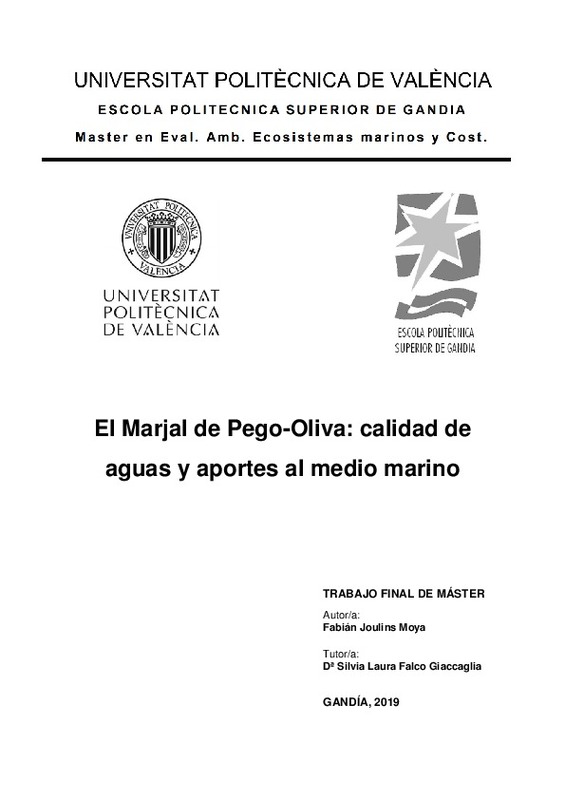|
Resumen:
|
El Marjal de Pego-Oliva es uno de los ecosistemas litorales más importantes de la Unión Europea, dada su elevada biodiversidad tanto de aves como de flora autóctona, y por su grado de aprovechamiento económico a través de ...[+]
El Marjal de Pego-Oliva es uno de los ecosistemas litorales más importantes de la Unión Europea, dada su elevada biodiversidad tanto de aves como de flora autóctona, y por su grado de aprovechamiento económico a través de los cultivos de arroz y cítricos. Además, cuenta con un régimen hidrogeológico muy complejo, cuyas aguas acaban en el mar. Por tanto, durante este trabajo, se han tomado muestras de agua repartidas en puntos estratégicos del humedal, para determinar la calidad de las mismas a lo largo de su paso por el marjal, y a su vez, tratar de llevar a cabo una estimación del aporte de nutrientes al medio marino a través de los dos ríos que flanquean y desaguan esta zona (Racons y Bullent). Se espera que, además, los resultados obtenidos permitan establecer si la calidad del agua proveniente de los ríos en su inicio, varía a medida que va atravesando las distintas áreas del marjal. Se han tomado muestras y medido las concentraciones de nitrógeno inorgánico disuelto
(NID), fosfatos (PO4
3-
) y silicio reactivo disuelto (DSi), en 6 puntos del Marjal de PegoOliva, durante un periodo de 61 días. Los dos ríos que flanquean el marjal han mostrado
por lo general, mayores concentraciones de nutrientes que un ullal natural y uno de los
canales de drenaje (el canal del Barranquet). El ullal ha mostrado signos de buena
calidad del agua, teniendo en cuenta la concentración de nutrientes, y el canal del
Barranquet, dentro de un comportamiento similar, se mostró no obstante más vulnerable
a los efluentes agrícolas u otros vertidos. Se han obtenido también elevadas
concentraciones de silicio, reflejadas en unos aportes al medio marino, por parte del río
Racons, mayores que en otros estudios. Las precipitaciones han demostrado tener un
importante papel en este entorno, pues se ha detectado relación entre episodios de
lluvia intensa y aumentos en las concentraciones de nutrientes en la mayoría de
localizaciones. Por último, ha quedado patente la necesidad de emplear una
metodología estandarizada a la hora de evaluar la calidad de las aguas del Marjal de
Pego-Oliva.
[-]
El Marjal de Pego-Oliva is one of the most important coastal ecosystems of the European Union, given its high biodiversity of both birds and native flora, and its degree of economic use through rice and citrus crops. In ...[+]
El Marjal de Pego-Oliva is one of the most important coastal ecosystems of the European Union, given its high biodiversity of both birds and native flora, and its degree of economic use through rice and citrus crops. In addition, it has a very complex hydrogeological regime whose waters end up in the sea. Therefore, during this work, water samples have been taken at strategic points in the wetland, to determine the quality of them throughout their passage through the marsh, and also, try to carry out an estimate of the contribution of nutrients to the marine environment through the two rivers that flank and drain this area (Racons and Bullent). It is expected that, in addition, the obtained results allow to establish if the quality of the water coming from the rivers at the beginning, varies as it goes through the different areas of the marsh. Samples were taken and the concentrations of dissolved inorganic nitrogen (NID),
phosphates (PO4
3-
) and dissolved reactive silicon (DSi) were measured in 6 points of the
Pego-Oliva marsh, during a period of 61 days. The two rivers that flank the marsh have
generally shown higher concentrations of nutrients than a natural spring (ullal) and one
of the drainage channels (the Barranquet canal). The ullal has shown signs of good water
quality, regarding the nutrient concentration, and the Barranquet canal, within a similar
behavior, was nevertheless more vulnerable to agricultural effluents. There have also
been high concentrations of silicon, reflected in a higher flux to the marine environment,
by the Racons River, than in other studies. Precipitation has been shown to play an
important role in this environment, since a relationship has been detected between
episodes of heavy rainfall and increases in nutrient concentrations in most locations.
Finally, it has become clear the need to use a standardized methodology when
evaluating the quality of the Pego-Oliva Marsh waters.
[-]
|







